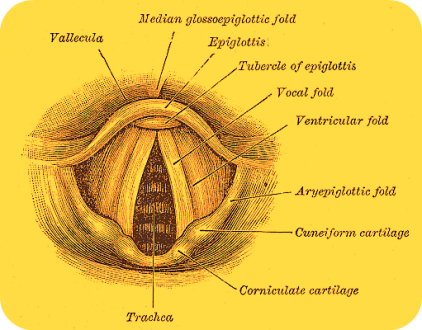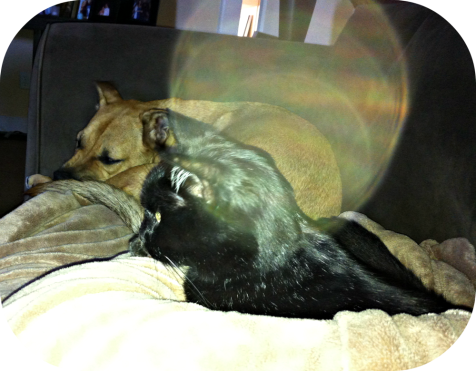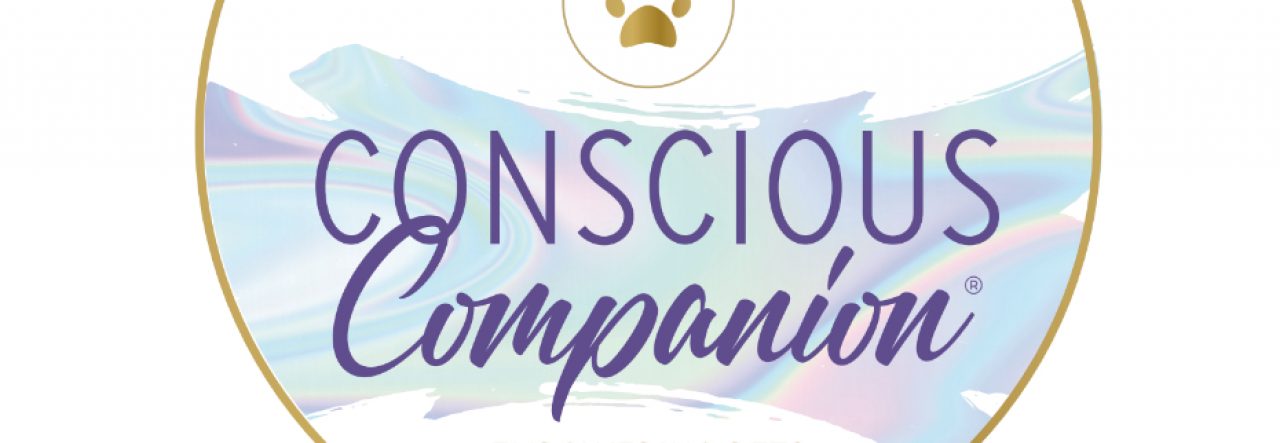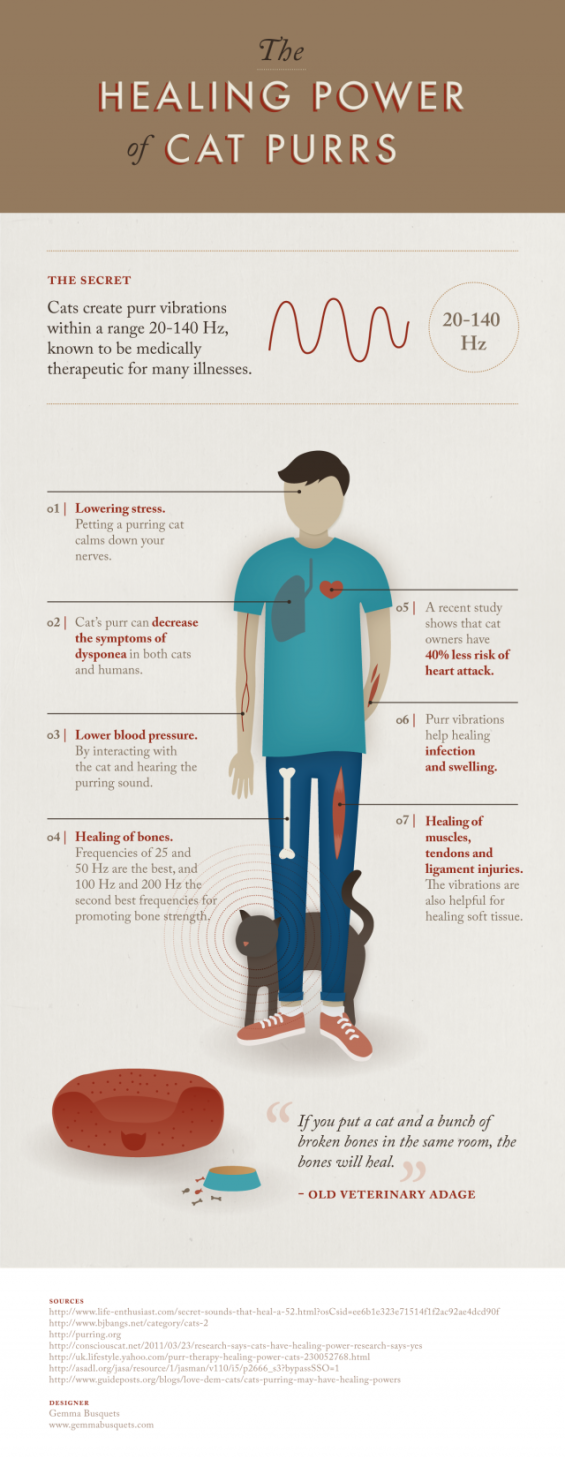Have you ever wondered how and why cats purr?
If you have lived with cats, loved a cat, or had the pleasure of petting a content cat, then you know how cool it is to hear and feel them purr. Most of us think that purrs happen when a cat is content, but cats actually purr at many other times as well. Let’s take a look at what we know:
What We Know
- Purring is one of many behaviors that cats use to communicate their emotional and physical state of being.
- It is the unique anatomy of felines which makes this sound possible.
- Cats purr when they’re experiencing pleasure. They purr when they are stressed, while they are giving birth, and when they are in pain.
Fun Fact: Cats aren’t the only animals that purr! Rabbits, squirrels, guinea pigs, tapirs, ring-tailed lemurs, elephants, raccoons and gorillas make purring sounds too – often while eating.

How Cats Purr
Science is still trying to demystify the purr. But the general consensus of veterinarians and scientists is that purring doesn’t actually originate from the throat. Basically, the unique feline anatomy provides the structure and physiology that causes the purring.
Below is an image of a cat’s throat that shows the kitty “music maker.” The glottis is a part of the larynx or voice box and the slit-like opening between the vocal cords. The alternating action of the laryngeal muscles and the diaphragm produce air movement within the larynx. This causes a buildup of air pressure. The air is then released through the glottis. The repetitive opening and closing of the glottis gives purring its unique sound. This is how we are able to feel the movement within your cat when we place our hand on her side or under their throat.
The frequency of the glottis movement is about ten times that of normal respiration, according to Dennis Turner in his book The Domestic Cat: The Biology of Its Behavior. The purr resulting from these vibrations have been found to have a range in frequency, and the frequency themselves may be part of the communication that the cat is trying to convey.

The vibrating folds of the glottis are what actually create a purring sound.
Not All Cat Purrs Are Created Equal
Manipulation of the vocal cords produces the different vocalizations that cats all around the world can create. But a purr is a bit different, depending on the species. Domestic cats (Felis catus) purr, but Big Cats (Genus Panthera) do not technically “purr”. – At least not by using the same mechanism as house cats. A 2002 study in Mammal Review reported that true purring is only seen in the scientific families of Viverridae and Felidae. The mechanism varies with each species. For the most part, it’s the semi-domestic cat (your cat at home) that produces the purring sound in its true form. Wild cats (lions, caracal, serval, puma, ocelot, cheetah, leopards) do purr, but it’s not a “true” purr . (But don’t tell the big cats that!)
Why Cats Purr
No one really knows exactly why cats purr. It could be for social reasons — to get the attention of their human or to create a bond with their offspring or their mother. Research suggests that purring also has restorative properties for healing and reducing stress. Scientists have proposed that when a cat purrs while in distress, pain, or giving birth, they are purring to trigger the brain to release pain killing hormones. This may be related to healing. Some scientists say that cats might even purr to manipulate their humans or their environment.
We all know that it’s natural for a cat to do what a cat does best – to get something they want. Call it the power of Purr-suasion, if you will. According to a study at the University of Sussex, cats will purr to gain food, attention, or affection. This behavior mainly happens with indoor cats that have a close relationship with their human. Purring, coupled with a high-pitched “purr-whine” can get their human to pretty much give into whatever the cat wants.
Admit it. You have done this when under the powerful pull of the feline purrsuasion. One study suggests that the high-pitched purr is very close to the high-pitched whine of a child, and makes it almost irresistible for owners not to investigate why the cat is making the sound. I don’t know about this theory because I will run from the sound of a shrieking child. However, if I were to really be objective about this, I have to admit that when my kitties cry or whine I do get up and attend to their feline needs.
Karen McComb, PhD headed a study to explore the unique characteristics of these insistent purrs after wondering why her own cat could be “so annoying.” In the study, recordings of 10 cats’ purrs revealed that cats sometimes develop a “twist on purring.” Cats can add a vocalization into the mix to solicit responses from humans. McComb’s team suggests that cats may have learned how to tap into a mammalian response for nurturing offspring by embedding a cry within a call that’s normally associated with contentment.
Added to the basic 25 Hz purr is an overlay of a high-frequency cry-meow that humans perceive as somewhat obnoxious. Cats apparently learn to do this to get people to feed them sooner.
Purring is also associated with being content around others. One study suggests that purring can be an attempt to be friendly to other cats, to other people, or to signal a specific intent. For example, when a cat is being petted, asking for food, or even purring at the scary veterinarian’s office, purring could be a way to communicate ‘friendship’. This study suggests that purring encourages humans to continue petting the cat, giving him or her attention, receiving food, or in the case of the veterinarian or an injury, to not hurt the cat. In essence, the cat is stating that he or she is not a threat by purring.
Feline Fact: Cats actually have a range for their purring, similar to how humans hum in different pitches. A cat’s purring frequency ranges between 25 and 150 Hertz
The Healing Properties of a Purr
Scientists have discovered that purring is a “natural healing mechanism.” They have discovered that wounded cats (both wild and semi-domestic) purr because it helps their bones and organs to heal. Fascinatingly, exposure to similar sound frequencies has been shown to improve bone density in humans! Scientists have also learned that cats release endorphins while purring. Endorphins are a natural analgesic that assists to reduce pain during the healing process.
Old wives’ tales usually have a grain of truth behind them, and most people have heard of a cat’s “nine lives.” There is also an old veterinary adage still repeated in veterinary schools which states, “If you put a cat and a bunch of broken bones in the same room, the bones will heal.” Any veterinary orthopedic surgeon will tell you how relatively easy it is to mend broken cat bones compared with dog bones which take much more effort to fix, and take longer to heal. ~ The Felid Purr: A bio-mechanical healing mechanism
Veterinary orthopedic surgeons have observed how relatively easy it is to mend broken cat bones, as compared with dogs. In a study of “High Rise Syndrome” found in the Journal of the American Veterinary Medical Association, Dr. Whitney and Dr. Mehlhaff documented 132 cases of cats plummeting from high-rise apartments, with the average fall being 5.5 storeys (55 feet). The record height for survival was 45 storeys. Ninety percent of the 132 cats studied survived even though some had severe injuries. There is also literature that suggests that domestic cats are in general less prone to postoperative complications following elective surgeries.
But are purrs to thank for this healing? Researchers believe that self-healing is the survival mechanism behind the purr, specifically during times of pain, injury and distress. There is extensive documentation that suggests that low frequencies, at low intensity, are therapeutic. These frequencies can aid bone growth, fracture healing, pain relief, tendon and muscle strength and repair, joint mobility, the reduction of swelling, and the relief of dyspnea, or breathlessness.
Purring really cannot be considered a true vocalization, as the purr is produced under differing emotions or physiological states.
Researcher Elizabeth von Muggenthaler of the Fauna Communications Research Institute in North Carolina (FCRI), a specialist in the field of bioacoustics, put it all together. Bioacoustics is the study of the frequency, pitch, loudness, and duration of animal sounds as it relates to the animal’s behavior. Based on her research, she proposes that nature has endowed all kinds of felines with an evolutionary healing advantage in the simple act of purring.
Remember that purring takes energy and cats purr not only when all is well, but also when the cat is giving birth, hurt or just scared. There has to be a very good reason for the energy expenditure to produce purring, especially when the cat is physically stressed or ill. It would have to be somehow involved in its survival. Muggenthaler set out to find how; you can read a summary of her study and results here.
It’s important to note that purring takes a lot of energy. Getting a diaphragm to move for something other than breathing is difficult. When there is pain and suffering, our bodies are traumatized and they shut down non-essential activity. Since cats purr when they are severely injured or dying, we can assume that it must be survival-related. ~Elizabeth von Muggenthaler of the Fauna Communications Research Institute in North Carolina
Cats purr during both inhalation and exhalation with a consistent pattern and frequency between 25 and 150 Hertz. Various investigators have shown that sound frequencies in this range can improve bone density and promote healing.
Purring While In Pain or Distress
- Samantha purred every time she was at the vet with me. I knew she was not purring because she was “happy”. She was self soothing.
The Sweet Sounds of Samantha Purring

Good Vibrations!
Cats have far surpassed dogs as the number one pet in the U.S., where 60% of homes have at least one pet, says Rebecca Johnson, PhD, RN, FAAN, director of the Research Center for Human Animal Interaction. Maybe one reason is because cats do a better job of lowering stress and blood pressure than many other pets, and purring may help with that.
Purring is an auditory stimulus that people attribute to peacefulness and calmness. Whether right or wrong, we generally construe it as something positive. That gives us positive reinforcement for what we’re doing and can contribute to the whole relaxation effect when we interact with our cats.







Another wonderful blog about our feline friends!
LikeLike
Thank you! I was inspired by one of my greatest teachers, Miss Samantha =^..^=
LikeLike
Thank you so much for this wonderful information. And bless you for sharing a little bit of beautiful Samantha with us. She was such an angel! Such a wonderful thing that you captured her energy!
p.s. Great to see Casey!
LikeLike
Pingback: Is Your Cat Having A Painful Day? : How to Recognize If Your Cat Is In Pain | Scoop The Poop!
Enjoyed this post and thought I’d share about my Sphynx cat Adam. He purrs loudly at the vet, but I suspect this is more due to his personal history than due to stress.
When I worked at a vet clinic, I occassionaly boarded him over the weekend when we went out of town. Two of my coworkers doted on him anytime he was in the building, and he got carried around in Aunty Erna’s arms a lot. Since he is so unusual looking (Sphynx cats are hairless), he always gets lots of petting and attention at the vet’s, even if he doesn’t get cuddled as much as when I worked in a clinic. To this day his demeaner at the vet is more “Ah, great. We’ve arrived at the place where my admirers live,” than “I hope nothing bad will happen.” – Laurel
LikeLike
Pingback: 33 More Awesome Facts About Cats | Darnmeme
Pingback: Building a High Powered Buyers List! » 33 More Awesome Facts About Cats
Pingback: 33 More Awesome Facts About Cats | view3d.tv
Pingback: Will It Be The Eve of Chaos or Calm? | Conscious Companion
Pingback: 33 More Awesome Facts About Cats | ViralTrail.com
Pingback: 33 More Awesome Facts About Cats – Weird Facts About Animals
Pingback: 33 More Awesome Facts About Cats – Shoiknya Social
Pingback: 33 More Awesome Facts About Cats | Photawn
Pingback: 33 More Awesome Facts About Cats – New Day Digest
Pingback: 33 facts about cats – Site Title
Great article on cats purring, I learned a great deal about a cat’s purring. When my cats are next to me purring all feels right in the world.
LikeLike
Pingback: Covert Cougars! – Conscious Companion